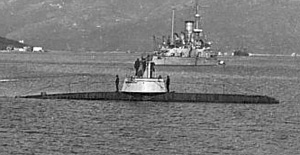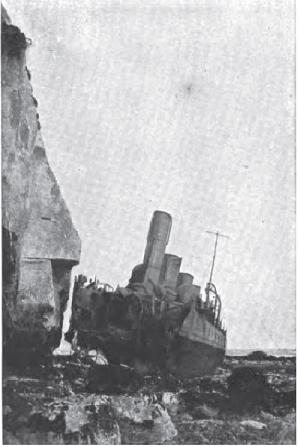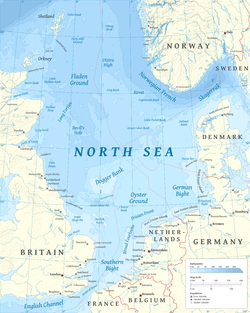HMS Faulknor was a British destroyer of the First World War. She was purchased by the Royal Navy whilst still under construction in Britain for the Chilean Navy who had ordered her in 1912 as part of the Almirante Lynch class. She was renamed after the Faulknor family of British nineteenth century naval officers.
SMS G37 was a 1913 Type Large Torpedo Boat of the Imperial German Navy during World War I, and the 13th ship of her class.
SMS G42 was a 1913 Type Large Torpedo Boat of the Imperial German Navy during World War I, and the 18th ship of her class.
SMS G41 was a 1913 Type Large Torpedo Boat of the Imperial German Navy during World War I, and the 17th ship of her class.

SM UB-10 was a German Type UB I submarine or U-boat in the German Imperial Navy during World War I.
SM UB-13 was a German Type UB I submarine or U-boat in the German Imperial Navy during World War I. The submarine was probably sunk by a British mine net in April 1916.

SM UB-16 was a German Type UB I submarine or U-boat in the German Imperial Navy during World War I. The submarine was sunk by a British submarine in May 1918.
SM UB-17 was a German Type UB I submarine or U-boat in the German Imperial Navy during World War I. The submarine disappeared during a patrol in March 1918.

SM UB-2 was a German Type UB I submarine or U-boat in the German Imperial Navy during World War I. She sank eleven ships during her career and was broken up in Germany in 1920.

The Battle of Dover Strait that occurred on 26–27 October 1916 was a naval battle of the First World War between Great Britain and the German Empire. Two and a half flotillas of German torpedo boats from the Flanders Flotilla launched a raid into the Dover Strait in an attempt to disrupt the Dover Barrage and destroy whatever Allied shipping could be found in the strait.
HMS Murray was a Royal Navy Admiralty M-class destroyer. Ordered before the outbreak of war, she was therefore the first of her class to enter operation during the early months of the First World War. She was also the first vessel of the Royal Navy to carry the name HMS Murray.
SMS G96 was a large torpedo boat of the Imperial German Navy that was built and served during the First World War. She was the prototype ship of the 1916 Mobilisation Type torpedo boats, and was launched at Germaniawerft's Kiel shipyard on 19 September 1916, completing in December that year.

SMS V47 was a V25-class Large Torpedo Boat of the Imperial German Navy that was built and served during the First World War.
HMS Mentor was a Hawthorn Leslie M-class destroyer of the British Royal Navy. Built by the Tyneside shipbuilder Hawthorn Leslie between 1913 and 1915, Mentor served during the First World War. She formed part of the Harwich Force in the early years of the war, taking part in the Battle of Dogger Bank and then later in the English Channel as part of the Dover Patrol. She survived the war, and was sold for scrap in 1921.
SMS S34 was a V25-class large torpedo boat of the Imperial German Navy that served during the First World War. She was built by the Schichau-Werke shipyard in Elbing, East Prussia in 1913–1914 and was completed in being launched on 4 April 1914 and was completed in November 1914.
SMS V26 was a V25-class torpedo boat of the Imperial German Navy that served during the First World War. The ship was built by AG Vulcan at Stettin in Prussia, and was completed in June 1914.
HMS Melpomene was a Medea-class destroyer of the British Royal Navy. She was one of four destroyers, of similar design to the British M-class ordered by Greece in June 1914, which the British purchased during construction owing to the outbreak of the First World War.
SMS V28 was a V25-class torpedo boat of the Imperial German Navy that served during the First World War. The ship was built by AG Vulcan at Stettin in Prussia, and was completed in September 1914. The ship took part in the Battle of Dogger Bank, the Battle of the Gulf of Riga in 1915, and the Battle of Jutland on 31 May 1916.
SMS S15 was a V1-class torpedo boat of the Imperial German Navy. The ship was built by Schichau-Werke, at their Elbing shipyard, completing in 1912.
SMS S20 was a V1-class torpedo boat of the Imperial German Navy. The ship was built by Schichau-Werke, at their Elbing shipyard, completing in 1913. S20 served with the German High Seas Fleet during the First World War, taking part in the Battle of Jutland in 1916 and moved to Flanders later in 1916. The ship was sunk by cruisers and destroyers of the British Harwich Force on 5 June 1917.


![Admiralty Chart No 3371 Dunkerque to Hook of Holland (1949) [enlargeable] Noordhinder Bank near left margin Admiralty Chart No 3371 Dunkerque to Hook of Holland, Published 1949.jpg](http://upload.wikimedia.org/wikipedia/commons/thumb/a/a3/Admiralty_Chart_No_3371_Dunkerque_to_Hook_of_Holland%2C_Published_1949.jpg/220px-Admiralty_Chart_No_3371_Dunkerque_to_Hook_of_Holland%2C_Published_1949.jpg)





